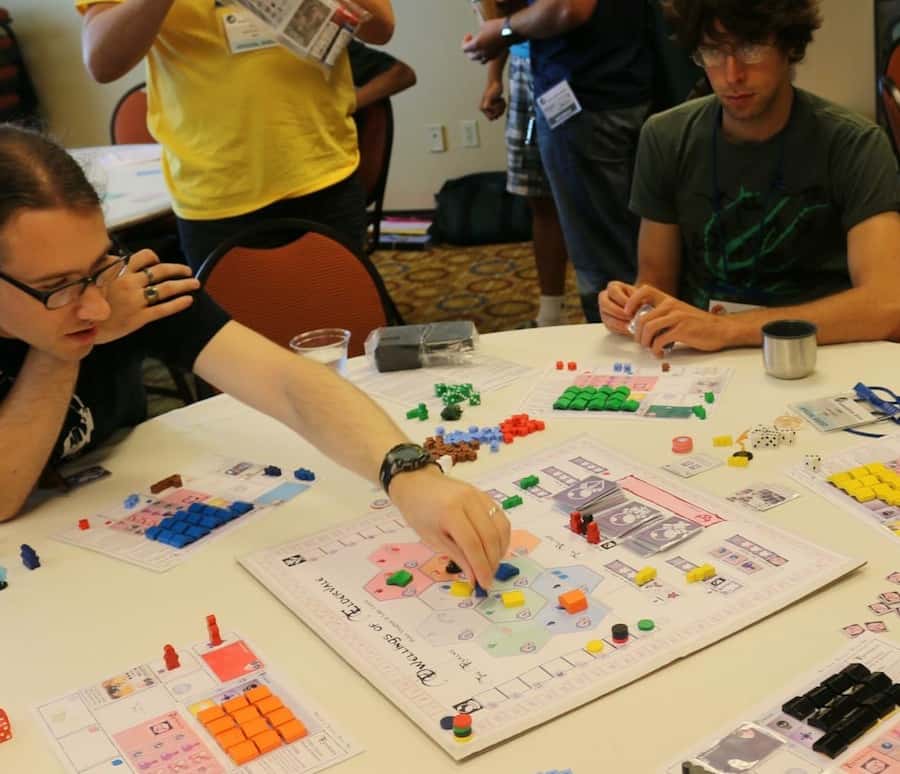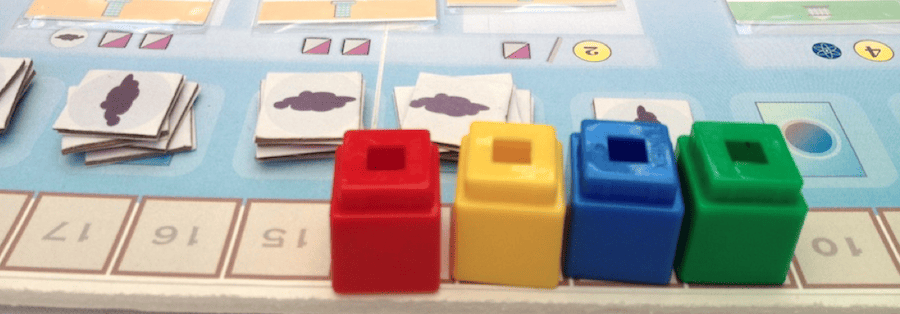
Playtesting games can be fun, insightful, and productive. It can also be disappointing, frustrating, and uncomfortable. Worse still, sometimes, playtesting is simply a waste of time. With the best games still yet to be made, we need to ensure that prototypes are getting solid testing and productive feedback. This series will explore the many facets of playtesting.

SET THE STAGE FOR SUCCESS
One of the keys to good playtesting is to establish norms of conduct and to create an environment conducive to productive work. Rather than just walking in to a random location and plopping your game down in front of unsuspecting strangers, it’s wise create an environment that will foster productive work.
I recently ran a protospiel event at Celesticon in Fremont, California, so I had the opportunity to set the stage, not just for my own playtests, but for the scores of playtests that would occur throughout the weekend.
During the entire convention, we had a designated 50-person meeting room to be used exclusively for playtesting games – not demoing, not selling, not pitching, not running tournaments, just playtesting. In this space, we had a controlled environment, an abundance of playtesters, and the authority to set our own rules.
I arranged for Saturday morning to begin with an orientation session to be attended by as many participants as possible. During this session, I focused on setting the ground rules to ensure there would be productive playtests, and to avoid some of the problems that can detract from a playtesting experience. I provided a flyer for all attendees and delivered a lecture emphasizing the playtesting guidelines below.
Celestispiel was very successful and productive for attendees. On the post-con surveys, designers reported, on average, that their playtests were “very useful” with many reporting their playtests were “vital.” I believe the guidelines we established at the beginning were a key part of that success.

PLAYTESTING GUIDELINES
The primary guideline for Celestispiel was this: “Participants are expected to give as much time as they take – in other words: run your own games, but also play the games of others.” I adapted this concept from people I’ve spoken to who have run Protospiel events. In addition, I established the following specific guidelines:
RUNNING PLAYTESTS
DO:
- Be polite and patient with your playtesters. By playtesting your game, these people are doing you a favor. They won’t always understand everything you say, they’ll make mistakes in playing, and they’ll make you repeat yourself. That said, any one of them might have a suggestion that will really help your game. Perhaps they’ll become strong supporters of your work. Better still, perhaps they’re connected to a major publisher and they might just sign a contract with you. If you’re polite, you’ll keep lines of communication open.
- Adjust your teaching to the level of experience and style of your players. Ask your players if they’ve played games that might share similar mechanics or strategy to your game. If so, you can compare your game to those other games to make teaching procedures easier. Find out if your players usually play light, medium, or heavy games, and keep their level of experience and preferences in mind throughout the playtest.
- Be clear about the theme, mechanics and stage of development of your game. Make sure your playtesters know what they’re getting in to. After describing your game in detail, give your players an out. If they’re still interested, they’ll be engaged players. If they learn your game isn’t what they’re looking for, let them go find another game that suits they’re interest or ability.
- Be respectful of time. This is a big one. Let players know how long the game will take, and stick with that duration. If your game is taking too long, suggest that you can end the playtest – or if players wish, you can see it through. But don’t drag it out. If the game takes too long, your playtesters may not stick around to give you much feedback.If your playtest is not going as planned and the game is having major problems, stop. Acknowledge that you’ve learned that there are major problems and talk it over with your playtesters. You are not required to finish every game.
- Feel free to make revisions and rule changes on the spot. If you recognize issues that can easily be changed, change them. Think of your playtest like you’re cooking a meal, and as you start to taste what’s cooking, you may realize something it really needs. Write on your cards, grab some extra pieces, or remove parts that aren’t working –as long as you’re not making people wait.
- Use feedback forms. It’s a good idea to get written feedback, for a variety of reasons. Sometimes some suggestions/complaints/criticisms are easier to explain in writing than they are verbally. For the designer, written comments are harder to ignore. Letting players write feedback also lets the players know that you take their feedback seriously. Even when they are not writing on forms, you should keep your own notes of their verbal feedback. An idea that sounds outrageous to you in the moment might make perfect sense to you later on when you review these notes.
DON’T:
- Don’t give players all the rules at once. Give players just enough information to play. Answer their questions. Add more information when it’s pertinent. “Just a heads up here. In a couple of turns we’ll be entering the end phase, and you’ll be scoring those achievement tokens.” Avoid giving the history or justification for the various elements of your game, that information can be distracting to players that are trying to experience and test the game as it is.
- Don’t camp on tables in the playtest room. During an event without a defined schedule, it’s important to make space available for the designers and players who need that space. once you’ve finished a playtest, vacate the table for another designer to use, unless there are plenty of empty tables.
- Don’t get defensive when you receive feedback. You’re almost guaranteed to hear things you don’t like, and things you don’t agree with. Listen to these comments, try to understand their feeling or perspective, and try to discern the origins of their perspective. Then, take these comments and file them with all the other feedback. Keep in mind that this feedback may be from limited exposure to your game – related to this being a first-time play. Whatever you do, don’t tell the playtester they are wrong or unjustified. Accept the fact that your game likely has issues, and even if it’s fabulous, some people are going to hate your game no matter what, even if its the next Catan or Dominion.
- Don’t ask your playtesters loaded questions, “Is my game not awesome?!” Guess what, you’ll learn nothing from them, no matter how they answer. Don’t delude yourself with confirmation bias (even if you know your game really is awesome).

BEING A GOOD PLAYTESTER
DO:
- Choose to playtest games that fit your gaming preferences and style. You can make your playtesting experiences more enjoyable by choosing games within the spectrum of games you usually like to play. If you are familiar with other games within the same genre or mechanical style, you’ll be able to offer feedback that’s informed by knowledge of similar games. If you do step outside of your usual range of games, keep that in mind as you provide your feedback.
- Try your best to learn the rules quickly, but don’t worry about knowing all the details at the beginning. Give the designer all of your attention and mental energy, to help make the playtest start quickly and run smoothly. Be ok with figuring out some parts of the game as you go along. Winning is not your primary goal- helping this game become better is.
- Play the game the way it is meant to be played. Pursue strategies and explore choices available in the game as players should. Yes, you can try to break the game by finding overpowered effects and interactions, but don’t break the playtesting experience through bizarre behavior. “You know, I passed every turn, because that was an option, and frankly the game was pretty boring.” “I took a random card every turn instead of selecting purposefully, and really, the game seemed very random. You should make a rule to prevent that.”
- Ask questions, but save deep discussion until after the game is over. Too many questions and interruptions can ruin a playtest. Undoubtedly, you’ll need to ask questions about how aspects of the game work. Save your deeper philosophical questions for the post-game debriefing.
- Take notes if necessary. Take notes on issues that come up during the game. Write down design questions. Help keep side discussions to a minimum. Prevent yourself from forgetting useful feedback that you’d like to provide the designer. After the game, include those notes in your written feedback to the designer or post-game discussion.
- Focus on the game that is, not the game you want it to be. This one can be especially difficult at times when playtesting with designers. Each designer has their own style and preferences. Sometimes they’ll get very excited by the ideas they get while playing your game. “Change, this, change that, and redo this and your game will be perfect… for me!” Instead help the designer realize their vision. Offer your suggestions, but don’t demand or assert that the game must be done your way.
- Provide feedback that is clear, direct and honest. Say what needs to be said. Let them know what aspects of the game work, and which ones do not. Say what was fun, and what was not. Identify an area that you think needs the most work. Unless the game is very refined, you don’t need to belabor every detail, because those details will likely change as work on larger aspects continue.
DON’T:
- Don’t interrupt the flow of the game to make suggestions or criticisms. The middle of the game is not the time to discuss what the game could be, would be, or should be. Don’t make the designer justify elements of the game as they come up. Don’t tell stories or carry on lengthy side conversations. These interruptions will stop the flow of the game and drastically alter everyone’s perception of the game.
- Don’t judge the components or art of the prototype, unless the designer asks. Prototypes will vary greatly in how finished they look. Try to focus your playtesting on the “game” and the “gameplay”, not the physical representations of the game elements. That said, consult other resources on the League of Gamemmakers about building good prototypes.

What are your thoughts on playtesting? What guidelines do you use? What makes a great playtest for you? Do you have any playtesting horror stories to share?








